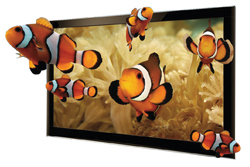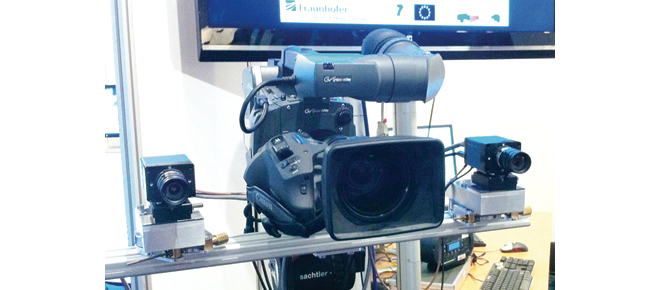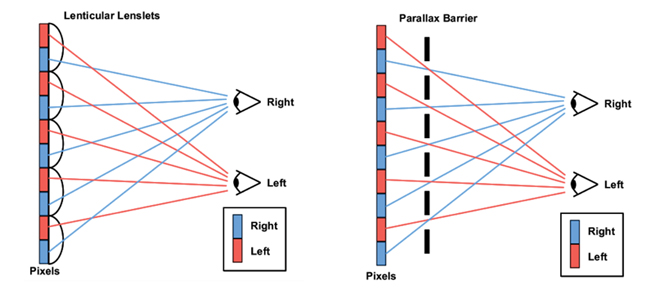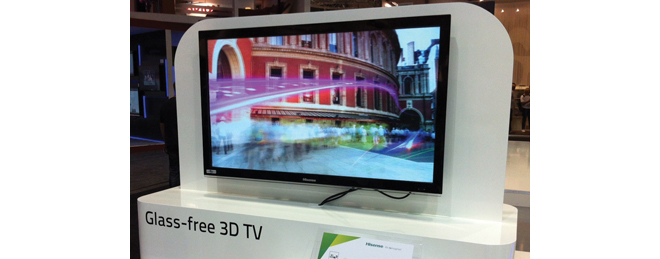Europe's online source of news, data & analysis for professionals involved in packaged media and new delivery technologies

FEATURE: Towards a viable auto-stereoscopic display solution
"Not until they come without glasses" is a common objection to buying a 3D TV. So, how likely are auto-stereoscopic 3D screens to become available in the foreseeable future at mass-market prices? BILL FOSTER suggests what we really need is not an evolution, but a technological revolution to drive the acceptance of auto-stereoscopy as a mainstream 3D display solution.
Auto-stereo 3D (A3D) displays have been around for several years, but until now they've been very expensive and generally offered a poor viewing experience when compared to their with-glasses counterparts. However, some recent developments indicate that this nascent technology may be starting to come of age.
As many readers will already know, auto-stereo screens work in a quite different way from stereoscopic 3D (S3D) TVs. In order to generate their "multi-view" image they require a depth map, either created at the point of production or from a pair of conventional stereoscopic images using a conversion tool, of which there are now several available. Performing the conversion in real time is processor-hungry and therefore currently quite expensive, but it's expected to be achievable as part of a TV's internal processing within a year or two.
Ideally, the depth map should be created at the point of production as this delivers a true multi-view image, enabling a viewer to look around an object as they would in real life. Using a stereoscopic source, on the other hand, results in the same S3D picture whatever the angle of view. (Hollywood may opt to continue shooting in S3D to ensure a uniform experience from any position).
A3D production and distribution
To generate an A3D image requires an entirely different camera set-up from those used for 3D today. A single high-resolution camera is flanked by two or more cameras of a similar (or lower) resolution and it is these which create the depth map. The result is referred to as 2D+Depth, or 2D+D. Using this method also creates better compatibility with 2D because it simply requires the image from the centre camera, while the depth information from the side cameras is distributed separately in a video format or as metadata.
How that distribution will be achieved over existing broadcast infrastructures or physical media formats has been investigated by groups such as the European 3D4YOU consortium, but as yet there are no standards. MPEG-MVC is capable of supporting 2D+D, although in a different configuration from that used by Blu-ray Disc, while Sisvel's "tile format" proposal (which has recently been extended to include provision for a depth map) delivers only 1280x720p resolution within a 1080p/25 frame if compatibility with existing decoders is to be maintained.
Some public service broadcasters in Europe have conducted 3D experiments, but in general they are still undecided on whether to launch frame-compatible (side-by-side/top-bottom) services like the pay TV operators. The problem they have is limited spectrum, bearing in mind that the numbers receiving their programmes over-the-air are higher in Europe than the US. The way digital broadcasting is structured in Europe, the majority of countries already have to simulcast SD and HD, unlike the US ATSC terrestrial system where the receiver chip scales an HD broadcast for an SDTV (and vice versa).
Because a frame-compatible service would therefore require a third allocation of spectrum in most European countries, there is a strong argument to adopt a service compatible format using either stereo 3D - with the second eye ignored by legacy TVs/STBs - or 2D+D. Because real-time encoding of MVC at the low data rates required for over-the-air transmission is still some way off, European broadcasters may choose to hold out just a bit longer and go with 2D+D. By that time auto-stereo displays could be available at an acceptable price point.
Compatibility with S3D displays
One potential problem with providing an infrastructure to support auto-stereo will be the need to continue servicing the growing installed base of stereoscopic displays that rely on two images to represent the left and right eye views. Depending on who one talks to, deriving two discrete images from 2D+D for stereoscopic display ranges from non-trivial to extremely complex; in any event it's more difficult than the reverse process.

The Fraunhofer Heinrich Hertz Institute in Berlin has come up with a novel approach to address 3D production during this interim phase. They've developed a multi-camera rig which incorporates a conventional mirror (or side-by-side) two-camera configuration flanked by two additional cameras to create the depth map (pictured above). The resulting output can deliver signals suitable for both S3D and A3D displays. This dual-format approach is supported by one of the MVC profiles, but would require owners of S3D TVs to buy a new STB because today's 3D TVs have no MVC capability.
Two different A3D technologies
Auto-stereoscopic screens, in addition to avoiding the need to wear glasses, have several other advantages. Not only can they deliver pictures which enable the viewer to see around an object, it is also possible, theoretically at least, to move around freely while watching without risk of losing synchronisation (shutter glasses) or having the feeling of wearing sunglasses indoors (polarised glasses).
"Theoretically" is the key word here, however, because today's auto-stereoscopic technology does not provide a seamless viewing experience. Anyone who has watched one of these panels will know about the annoying "jump" between views when shifting position from side to side. The situation is improving with each new model, but that jump is still there.
As Dimenco's Maarten Tobias described in last year's edition of DVD and Beyond, there are in fact two distinct categories of auto-stereoscopic display (pictured below), those based on parallax barrier technology and those using a lenticular lens. The former is best suited for tablets, mobile phones, Nintendo's 3DS and other single-viewer applications, while lenticular lenses are more commonly found on the larger panels that so far have been used primarily for commercial display purposes.

The principal drawback of all current auto-stereo displays is the trade-off between the number of views versus picture resolution, and the effect both of these have on the amount of depth that can be displayed without blurring or distortion.
The availability of 3840x2160, Ultra High Definition (UHD) panels is enabling auto-stereo TV manufacturers to deliver a marked improvement in image quality. With the 4x increase in pixel count, many more "views" can be achieved than the 8 or 9 offered by earlier models, while maintaining a resolution close to "Full HD."
Toshiba was the first to market with an auto-stereo display based on a UHD panel and others are now following their lead. On show at IBC was Dimenco's new 56?, 28-view UHD panel, which uses a lenticular lens combined with image processing developed by Dolby Laboratories and Philips.
Stream TV Networks claims to employ "proprietary technology" for its Ultra-D displays, but it would still appear to use a lenticular lens. The results from its earlier 1920x1080 LCD TV showed great promise and the latest offering - a LED back-lit auto-stereo UHD TV manufactured by Chinese TV manufacturer Hisence - was well received by those who saw it at IFA this summer (pictured below).

However, even when using a UHD display, there is still a compromise in terms of the degree of depth compared with what can be achieved on an S3D with-glasses display. In this writer's opinion, neither of the existing auto-stereoscopic technologies - parallax barrier or lenticular lens - is ideally suited for the purpose. Some new thinking is required in order to deliver images that will be acceptable to consumers for 3D viewing in the home over long periods of time.
Revolution, not evolution
What we really need is not an evolution, but a revolution to drive the acceptance of auto-stereo as a mainstream 3D display solution and there are a number of academic research projects striving to achieve this.
The University of Tokyo, for example, has been experimenting with integral photography, a process first discovered more than 100 years ago which is able to deliver considerable depth both in front of and behind the display, although there will inevitably be trade-offs and what the manufacturing cost might be is not clear.
The MIT in the US and Brunel University in the UK are among others working on new solutions. MIT has presented two projects at recent SIGGRAPH conferences: a multi-layer "tomographic image synthesis" technique aimed at increasing spatial resolution, depth of field and brightness, and HR3D (High-Rank 3D Display using Content Adaptive Parallax Barriers), which is claimed to provide vertical as well as horizontal parallax without loss of brightness.
Brunel's "full parallax" display, shown in prototype form at this year's IBC, refines the existing parallax technique and is linked to development work on holographic displays under the EU's 3D VIVANT project. All are very much at the laboratory stage and any commercial launch is definitely some way off.
No radically new developments were being shown by the major Japanese or Korean CE manufacturers at IFA or IBC, but there can be no doubt that their R&D departments are working hard behind the scenes to find a commercially viable auto-stereo solution.
Whatever alternatives or refinements to current lenticular lens and parallax barrier technologies emerge, if we want to lose the glasses it must deliver higher quality than either of them... and at a lower price point. Maybe CES 2013 will be the show where see some auto-stereo innovations that can deliver a 3D effect closer to what is achieved by today's with-glasses displays.
The case against glasses
Active shutter glasses in cinemas need to be durable and for this reason they are normally quite chunky. This doesn't appear to have been a major issue for cinema goers but it certainly is in the home. However, the downside of active shutter glasses designed for home use is that the more user-friendly they become (i.e. lighter), the more vulnerable they are to damage. There is also the problem that active shutter glasses driven by infrared tend to lose sync when the viewer looks away from the screen, something that will become increasingly commonplace with the advent of second screen. Fortunately, Bluetooth appears to be taking over as the transmission medium of choice.
Passive polarised glasses certainly provide a cheaper option, as well as being more comfortable to wear, but the arguments continue to rage over the lower resolution delivered by today's polarised HD screens. The new generation of Ultra High Definition TVs enable the delivery of full HD per eye using passive technology, but currently at a price premium that is likely exceed any savings from the use of polarised glasses. The cost of the UHD panel also brings their pricing closer to auto-stereo displays, which definitely need the higher resolution to be successful.

In the early 1980s, BILL FOSTER was closely involved with the launch of the Compact Disc; in the 1990s, he helped to establish a digital network linking post-production facilities worldwide utilising the then fledgling audio and video compression technologies, and towards the end of that decade set up a DVD authoring facility for the LA-based AIX Media Group. After more than 10 years working with Understanding & Solutions/Futuresource Consulting as their Senior Technology Consultant, Bill now operates his own technology consultancy, Digital Decoded, with particular emphasis on 3D and immersive audio. Contact: bill@digital-decoded.com.
This is one of many editorial features included in the annual DVD and Beyond 2012 magazine. Ask for your free copy.
Story filed 20.11.12




















